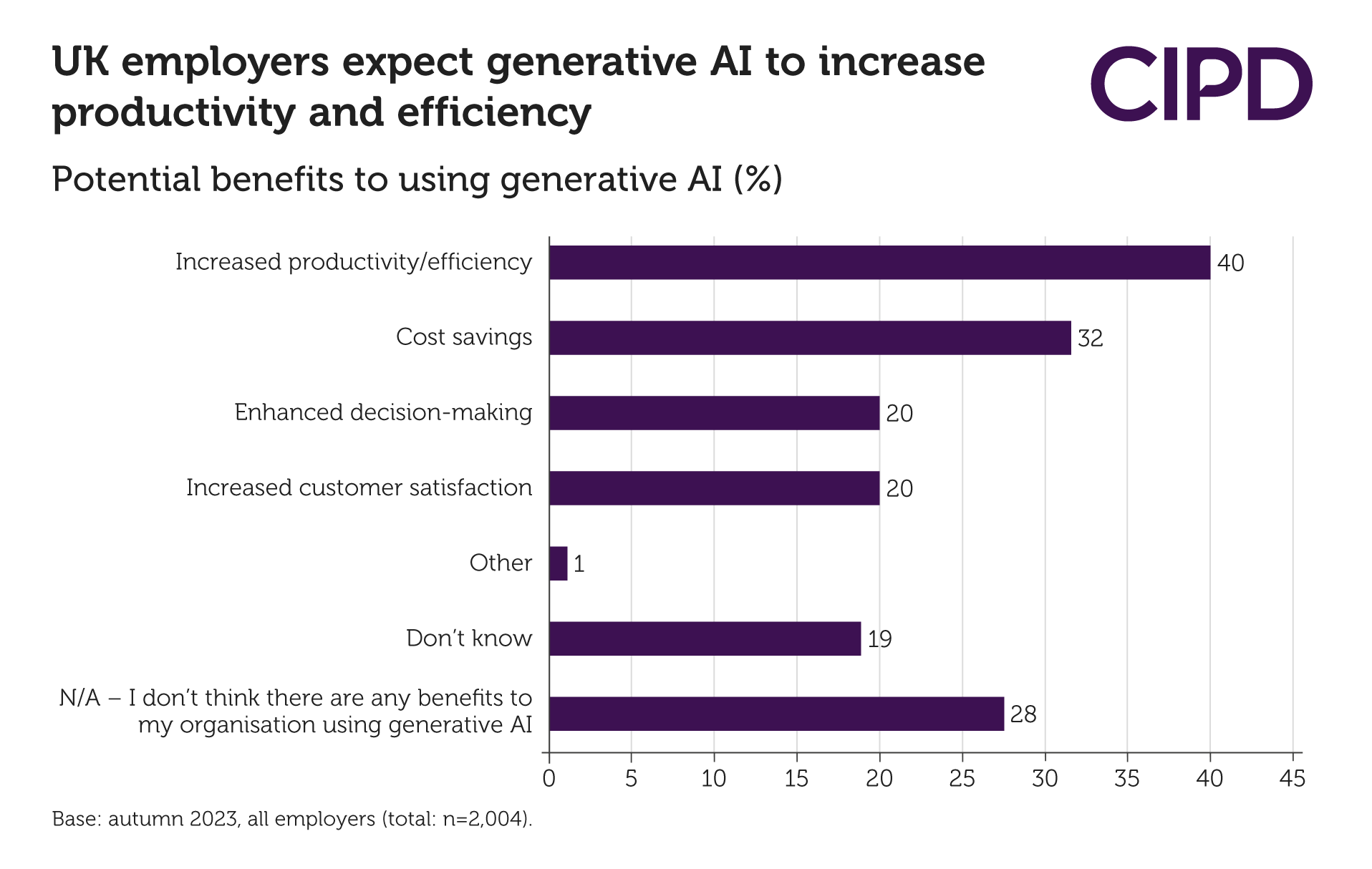
Employers moving to investigate, implement and invest in generative AI
CIPD research shows varied responses to generative AI use from organisations, as some explore opportunities to improve productivity
CIPD research shows varied responses to generative AI use from organisations, as some explore opportunities to improve productivity
The CIPD’s Labour Market Outlook – Autumn 2023 revealed that 41% of UK employers see generative AI as an opportunity for their organisation. Employers anticipated potential benefits including increased productivity or efficiency, cost-savings, enhanced decision-making and increased customer satisfaction, although some did not think there would be any benefits to their organisation.

A significant game-changer with the capacity to deliver fast and personalised outputs at scale, generative AI is having a growing influence over the nature of work, the workplace and future skills development. Our findings indicate that employers are not only becoming alert to the potential opportunities this technology offers, but are anticipating that it would increasingly shape their organisations and their workforce in coming years. In fact, a quarter of employers expect to increase full-time staff over the next five years due to the implementation of generative AI. Even now, many are taking active steps to investigate, implement and invest in generative AI use.
We asked employers what steps their organisation had taken to implement generative AI use in the last 12 months. Respondents gave a variety of answers showing that they are at different stages in their journeys. But what is apparent from the responses is that active exploration and experimentation is being undertaken, regardless of whether there is full understanding of what effective implementation of generative AI is.
The CIPD’s AI use in the workplace: Practical advice for HR professionals offers guidance on how organisations can get started by preparing a user policy on generative AI for the workplace and how the technology can be used to support HR functions.
Organisations that may be at an early stage in considering the use of generative AI are setting up working groups and taskforces to explore and discuss potential usage. Respondents said they were using these groups to understand the opportunities being presented and to identify where the technology can be implemented. Other organisations said they were testing the various platforms and options available as they consider the possible uses within their teams.
Meanwhile, other organisations said they were encouraging and briefing their people on using generative AI, particularly for doing repetitive tasks as well as to improve productivity. Some organisations are providing guidance “with examples of acceptable use”, others have gone so far as to give training to employees “on how to use the new AI tools and integrate them into their workflows”. Mandatory training was mentioned, but was not widespread.
Actual use of generative AI varied among organisations. Some were using it “regularly” for document creation, in many cases either to draft something which could be standardised or be repetitive in nature, or as a basis on which to develop ideas further. The technology was used to create social media, marketing and website content, letters to clients, bids and reports.
Within HR, the most common uses were to draft job adverts, policies, guidelines and emails to prospective applicants.
Outside of content generation, organisations were also using the technology to change, optimise and automate certain processes. Some used it for data analysis, writing code and to carry out “repetitive scheduling tasks”.
Beyond implementing AI use to carry out tasks or enhance processes, some employers were also looking ahead and investing in generative AI capability. The range of options organisations were taking included:
The following chart summarises the ways employers are approaching generative AI use in their organisations.

Use of generative AI within the workplace is set to become increasingly prevalent. Some employers are preparing not only for the impact this technology will have but also to see how AI capability can be best deployed to enhance organisational outcomes.
The ubiquity and low cost of tools like ChatGPT have ensured a fast uptake among workers. Employers who are not proactive will soon find themselves outpaced by developments as this technology will continue to progress and reach into new areas of our working lives. They should consider creating space and time for teams to test, experiment and understand generative AI’s potential for their business. HR teams can explore how the technology can be applied to improve processes and employee experience through different stages of the employee lifecycle. Further details on ways employers and HR teams can prepare their organisations for AI use can be found in our guide. You can also view other resources on AI and technology use on our AI in the workplace page.




Katie Stickland, CIPD Knowledge Exchange Manager, reviews research that examines how HR departments have utilised digital technology such as AI and analytics


Find out what people professionals said about their working lives and career development prospects in our recent pulse survey

As artificial intelligence continues its rapid advancement and becomes the much touted focus for investment and development, we highlight the critical role of the people profession and explain how the CIPD and its members will be involved shaping its impact at work

A look at whether artificial intelligence can cover skills shortages by exploring the benefits of AI and the advantages that can be gained by using generative AI such as ChatGPT

Jon Boys discusses the benefits of generative AI tools, and how organisations can utilise them